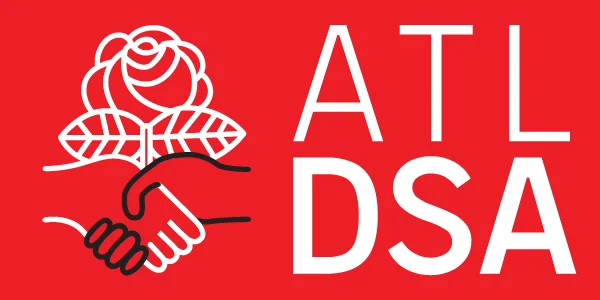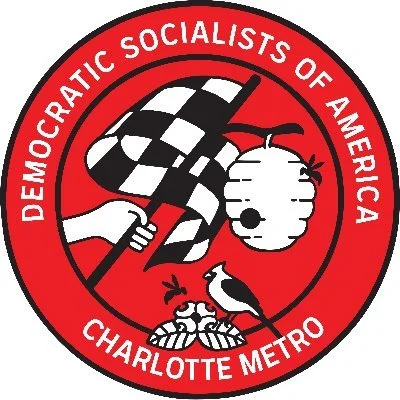

DSA Members run for Bernie Delegate in Georgia
Metro Atlanta DSA is proud to endorse Y’allidarity, a slate of DSA members running to represent Georgia at the 2020 Democratic National Convention as delegates pledged to our democratic socialist presidential candidate, Bernie Sanders.
This movement is bigger than Bernie. He said it himself: “not me, us.” Our members are running because even though Bernie has withdrawn, this movement is about all of us, the 99%, carrying forward the momentum behind Bernie’s candidacy. We have a responsibility to continue Bernie’s political revolution into a mass movement for democratic socialism that takes on the greed and hate of the capitalist class.
Even though Bernie has withdrawn, we still need to send democratic socialist delegates to the DNC to fight for working class demands: for Medicare For All, A Green New Deal, a Federal Jobs Guarantee, and a People’s Bailout. The Convention will be a huge political moment for the country, so having organized DSA members on the convention floor will be critical. We need to leverage this moment to popularize democratic socialism and demonstrate to the greater working class that there is an alternative, that a better world is possible.
Registration has already closed for the Democratic Party of Georgia’s online caucuses to select District-Level Bernie Delegates. If you’ve already registered, vote for the Y’allidarity Slate! You should get an email with a ballot to vote on Saturday, May 23rd at 9am, and you’ll have until 5pm to cast your vote.
Our Slate:
District 4: Catie L, Matthew Wolfsen, Kristen Oyler, Jon Skinner (only vote for these four, leave the rest blank)
District 5: Alexander Hernandez, V. Margot Paez, Nate K, Shaheen Rana, Ben Webb
District 6: Tracy Prescott, Daniel Hanley, Jeff Corkill, Jake Schenberg (only vote for these four, leave the rest blank)
District 7: Krupesh Patel, Ramin Zareian (only vote for these two, leave the rest blank)
District 9: Dean Trippe (only vote for this one, leave the rest blank)
Our Candidates:
District 4
|
|
Catie L
It was never about Bernie — it was always about us! I currently serve as an at-large officer on MADSA’s executive committee. I’m excited to represent Bernie voters from Georgia’s 4th district and fight for a party platform that all working people deserve! |
|
|
|
Matthew Wolfsen
I’m a Bernie volunteer, having spent countless hours, starting the weekend after New Year’s Day, making regular trips into South Carolina, mostly Greenville, to knock doors. I want to spend every last moment that I can advocating for Medicare for All, the Green New Deal, and College for All. Bernie’s campaign motto is “Not me, Us” and I will do everything in my power to ensure that his platform lives on so a younger generation can champion that same exact policy to become our future leaders. |
|
|
|
Kristen Oyler
The current crisis has made it glaringly obvious that the status quo protects the rich and corporate interests at all costs, even at the expense of the lives and livelihood of average Americans. In these dark times, Bernie and the movement of devoted activists he inspired have renewed my hope that we can change our country for the better. As a volunteer, I canvassed in early primary states and sent over 50,000 texts to build support for the Bernie 2020 campaign. I would be proud to represent Bernie Sanders and the socialist movement in Milwaukee. |
|
|
|
Jon Skinner
Bernie’s greatest legacy is giving millions the permission to ask for and expect more. This Bernie journey has meant everything to me, from canvassing in South Carolina and Georgia to phone banking folks in Washington & Nevada after work. Working people are suffering now more than ever and it would be my honor to go fight for them in Milwaukee. No more Republican-lite. |
|
District 5
|
|
Alexander Hernandez
I helped organize canvasses and debate watch parties all across Atlanta as part of the MADSA for Bernie campaign. This work was never meant to be easy. I’m excited to push the boundaries of the possible! |
|
|
|
V. Margot Paez
I’m a former Bernie Victory Captain and member of DSA. My mission is to make “Not Me, Us” a political reality. I look forward to working with my fellow delegates to take a truly progressive and socialist agenda to the Convention this summer. |
|
|
|
Nate K
I helped organize the MADSA for Bernie canvassing program, in which we knocked 10,000+ doors all across Atlanta with the help of hundreds of volunteers. We may have lost this battle, but the class war continues, and we need to cohere the Bernie movement around a democratic socialist agenda. I’m excited to carry this momentum forward, through the DNC and beyond! |
|
|
|
Shaheen Rana
I am a DSA member and I support Bernie Sanders for President. I support Bernie’s platform for Medicare for All, Green New Deal, and abolishing ICE. I have canvassed and phone banked for Bernie, and am excited to represent the socialist movement in Georgia. |
|
|
|
Ben Webb
As a committed Socialist and one of the organizers of MADSA for Bernie, I’d be proud to represent Bernie’s revolution in Milwaukee. As we stumble ever closer to disaster with COVID-19 and the climate crisis, we must fight back against the billionaires that control our society and the party establishment. We must fight against the narrative of restoring business as usual, both in the fight against COVID and against Trump, we must fight to transform our society through policies like Medicare for All and a Green New Deal, we must fight capitalism itself and forge a truly just world. |
|
District 6
|
|
Tracy Prescott
I’ve been a Bernie supporter since before 2015. I have been active in Georgia electoral politics and activism as a known DSA member. I’m a mom of badass kids, including a queer daughter who organizes for YDSA at her college, a communist 17-year old son, and two socialist feminists ages 19 and 17. The political revolution must go on bc status quo is not working for working people. |
|
|
Daniel Hanley
In 2016, I helped mobilize a van full of Bernie delegates and other radically democratic agitators to Philadelphia, where we demanded a party representing working class interests and values over the DNC’s wealthy donors corporate sponsors. Collectively our efforts resulted in democratic reforms to the Democratic Party, including limitations on the roles of superdelegates and progressive improvements to the party platform. In 2020, we face similar questions of electoral legitimacy and escalated crises of capitalism, so I’m even more committed to amplifying disenfranchised voices inside and outside the convention. |
|
|
Jeff Corkill
I supported Bernie in 2015 and this time around served on the MADSA for Bernie Steering Committee. I’d be honored to go to Milwaukee to support Bernie & socialist policies and represent DSA. |
|
|
Jake Schenberg
I am proud to be a part of the Bernie revolution. I phonebanked, textbanked, and served as a Victory Captain because I believe we must build a movement for equality, for justice, for Democratic Socialism. I would be honored to represent Bernie’s campaign and our movement at this year’s Democratic National Convention. |
District 7
|
|
Krupesh Patel
I came into the political revolution because of Bernie Sanders. I want to continue the fight for a habitable planet in Milwaukee. I been an active member of DSA since 2017 and currently help facilitate the eco-socialism working group |
|
|
Ramin Zareian
Bernie’s 2016 campaign inspired me to get involved in politics and embrace socialism. It would be an honor to represent Bernie’s supporters and the socialist movement in Georgia’s 7th congressional district. |
District 9
|
|
Dean Trippe
I’m a non-binary parent of three, an elementary school teacher, and comic book artist. I am wholeheartedly behind the #NotMeUs movement and am a proud DSA member. I support Bernie Sanders and the platform he represents, and I am a socialist who will represent our values and our solidarity in Milwaukee! |


Position On The Adirondack Pregnancy Center
Crisis Pregnancy Centers, or CPCs, are anti-choice organizations that masquerade as health facilities in order to trick women who are considering abortions. The goal of these centers is to plant themselves in close proximity to real abortion providers and divert potential clients away with deceptive advertising. Once inside a CPC, people are lied to, shamed, and pressured about their reproductive health decisions, often delaying their procedure or pushing them past the deadline for a legal abortion altogether.
One such center is on its way to Saranac Lake. Partnering with the notorious anti-choice organization Heartbeat International and approved by the Village Development Board to do business just one block away from the local Planned Parenthood, the Adirondack Pregnancy Center has all the tell-tale signs of a crisis pregnancy center (CPC). CPCs are unethical entities that employ deceptive, politically motivated practices, and the current project in Saranac Lake should be shuttered immediately.
This should not be a contentious issue in Saranac Lake. In addition to Carolyn Koestner’s comprehensive letter to the editor about CPCs in the March 10, 2020 issue of the Adirondack Daily Enterprise, there’s plenty of evidence that CPCs do not provide women with objective medical counseling on pregnancy options. The goal of these organizations is specifically to dissuade women thinking of having abortions by any means necessary, including false information about pregnancy and abortion.
In 2018, the American Medical Association (AMA) Journal of Ethics published an article titled “Why Crisis Pregnancy Centers Are Legal but Unethical.” Drawing on multiple undercover surveys of CPCs and detailed reviews of the centers’ promotional materials and websites, the study reports on how women who sought counsel at CPCs across the country were falsely told that abortions are linked to mental health issues and breast cancer. They were also told contraception is an ineffective means of preventing sexually transmitted infections.
In a segment on Last Week Tonight, John Oliver covers how CPCs often mislead women into waiting to get an abortion until it’s too late in their term to do so. Yet, because CPCs are not medically licensed facilities (Adirondack Pregnancy Center received a “Certificate of Incorporation” from New York State), they are able to give their clients misinformation without legal ramifications because of a “free speech” loophole.
That the Adirondack Pregnancy Center will be any different from these kinds of CPCs looks more and more unlikely the more digging you do. Their partnership with Ohio based Heartbeat International is particularly incriminating, given the sheer number of Heartbeat’s existing partner pregnancy centers worldwide that have been exposed for their disinformation practices. What’s the common denominator? Heartbeat International provides a handbook to their partners with “suggested scripts” that center workers can use to coerce their clients (see Last Week Tonight).
Not only does the APC have access to these harmful materials, their board members recently attended Heartbeat International’s Annual Conference, which is designed for those involved in “life-affirming” centers and provided the board with “invaluable training”. The keynote speaker for APC’s upcoming banquet is a paid speaker for the anti-choice movement.
It gets even worse: the owner of the domains www.adirondackpregnancycenter.com and www.adkpregnancycenter.com were both registered by an Ohio based company that on their own about page admits they “are experts at making sure your website is attracting the abortion-minded client.”
The company is currently in hot water for potentially exploiting personal medical information of pregnancy center clients. Clearly, the APC is backed by large, multi-national interests more invested in pushing an anti-choice propaganda campaign than actually helping women with unwanted pregnancies and allowing them to make their own decisions regarding their bodies.
If the proponents of the Adirondack Pregnancy Center are actually interested in providing quality care to pregnant women, they should obtain a medical license and engage in 100%-truthful, full-disclosure healthcare. Or they could help single mothers and other economically disadvantaged parents take care of and pay for their children, giving women with unwanted pregnancies a resource they can rely on should they choose to give birth.
Until either of those things occur, High Peaks DSA calls on the Village of Saranac Lake Development Board to take all available evidence on the unethical behavior of CPCs into account in a reconsideration of the board’s initial approval of the Adirondack Pregnancy Center. Failing that, we call on the people of Saranac Lake—the same community that stopped Walmart—to say “NO” to this entity and its deceptive practices that will bring harm to our community.
Additional Resources
- “The Adirondack Pregnancy Center – An introduction”
- Carolyn Koestner, “Protect reproductive rights; stop Adirondack Pregnancy Center”
- Laura Cunningham, “Women’s choice doesn’t seem to be pregnancy center’s priority”
- American Medical Association, “Why Crisis Pregnancy Centers Are Legal but Unethical”
- John Oliver, “Crisis Pregnancy Centers”
- openDemocracy, “Exclusive: Trump-linked religious ‘extremists’ target women with disinformation worldwide”
- Rewire.News, “How Anti-Abortion Organizations are Exploiting Personal Data”
- FactCheck.org, “Born Alive Baloney”
The post Position On The Adirondack Pregnancy Center appeared first on High Peaks DSA.


Dr. Edgar Rivera Colón on the Latinx Community, Sexuality, and the Churches


Dr. Edgar Rivera Colón sobre la comunidad latinx, la sexualidad, y las iglesias


Justice for Ahmaud Arbery
The Metro Atlanta DSA mourns the tragic death of Ahmaud Arbery, a black man who was senselessly murdered while jogging through his own neighborhood in Glynn county three months ago. No parent should have to watch their child be slain in such a disgusting way, for no reason other than racist hate. There is no question about it: this was a modern-day lynching.
This murder, and the subsequent refusal of the capitalist state to take action against the killers, reflects the despicable systemic racism that plagues our whole country. The fact that this crime has gone unaddressed for 3 months provides a glimpse into what black americans face in an environment built on racial profiling and white supremacy.
We unequivocally stand with the NAACP in demanding the resignations of District Attorneys Jackie Johnson and George Barnhill. We echo their call for justice for Ahmaud Arbery. We encourage our members and supporters to participate in the distributed Dedication Distance Run planned for this Friday, May 8th, in his honor.
REST IN POWER


May Day 2020: Atlanta Car Parade & Protest
Every Human is Essential
On May 1, 2020, Metro Atlanta DSA joined with a massive coalition of Atlanta-area unions and activist organizations to put on a car parade and protest against the unacceptable handling of COVID-19 by the Georgia state government.
Protesters’ demands included:
- State-funded paid sick leave for all essential workers
- State-funded hazard pay for all essential workers
- Expanded unemployment benefits
- Expanded medicaid coverage
- Expanded food stamp subsidies
- Moratorium on rent
- Decarceration of jails and ICE detention facilities
The showing was incredible! Upwards of 100 vehicles participated in the caravan.
DSA members erected a mock guillotine along the parade route and in front of the state capitol building. Their signs read, “WE ARE NOT PAWNS FOR YOUR PROFITS.”

“Cars in the caravan all drove by blasting their horns with their fists raised, as did quite a few people who were not demonstrating,” said DSA member Rachel K, who worked closely with other organizers to make the mock guillotine stunt a reality.
More photos from the car parade and protest:









Atlanta’s 2020 May Day demonstration was organized and sponsored by:
- Concerned Members Of ATU Local 732
- United Campus Workers Of Georgia
- Shift Change Atlanta
- Southern Workers Assembly
- National Nurses United
- Black Alliance For Just Immigration
- Community Movement Builders
- Atlanta Industrial Workers Of The World (IWW)
- Metro Atlanta Democratic Socialists Of America
- Science For The People – Atlanta Chapter
- Georgia Detention Watch
- Black Workers For Justice
- Workers World Party
- Georgia Peace And Justice Coalition
- Georgia Workers Alliance
- Housing Justice League
- New Orleans Hospitality Workers Alliance
Get involved with Metro Atlanta DSA
Never forget — the wealthy elites need us more than we need them. Without our labor, they would have nothing. When we stand together, we are unstoppable.
JOIN METRO ATLANTA DSA — SUPPORT OUR WORK


Heart of a Heartless World -Catholicism, Socialism, and Healthcare with Colleen Shaddox


Charlotte Metro DSA for Bernie
Today the people of North Carolina, 14 other states, and American Samoa will likely decide the Democratic nominee who will face Trump in the general election in November of 2020. Alongside chapters nationwide, the members of Charlotte Metro DSA have texted and called and knocked on doors in an effort to make sure that person is Senator Bernie Sanders. Since the chapter formally endorsed his candidacy in January , our small group has knocked on 1500 doors - going into neighborhoods every weekend to talk with community members about their struggles and the need for transformative change.
We asked several of our members to reflect on their experience with our local DSA for Bernie campaign, to share what they heard, and discuss why we need to elect Bernie Sanders.
“A woman told us she felt bad about the fact that she had to use her niece's insulin. Her niece was also on dialysis. After her insurance lapsed, she couldn't afford the insulin anymore. I've had several friends that have thousands of dollars worth of medical debt from needing to go to the emergency room, but none of them have needed something so crucial on a daily basis. This is why we need Medicare for All and Sanders is the only candidate truly standing up for it.”
— Corey
“Back in January we met a man who told us his 19 year old sister had just joined the military. Trump had just assassinated Soleimani and he was terrified that she would be deployed to Iran. He said Bernie is the only candidate he trusts to finally end the wars in the Middle East. Medicare for All and Bernie’s plan to make public colleges and universities tuition free also removes the coercive incentives that force poor kids to enlist just to get access to healthcare and education.
In the heavily gentrifying Belmont neighborhood we met a woman who said all but three families on her street had been pushed out of the neighborhood by new luxury development and rising rents. Charlotte at large also has a massive homelessness problem and an affordable housing shortage of 34,000 units. Bernie’s housing plan includes national rent control standards that would fight gentrification, protect tenants against rising rents, and invest $2.5 trillion into new affordable housing.”
— Dallin
“Only Bernie’s policies address the concerns of the American working class - this was made abundantly clear when I talked to people while canvassing. I talked to someone paying $200+ per month for medication, to someone afraid that their sister would be deployed and would die in another pointless war, to young and old people alike concerned that no one seems to be taking climate change seriously. Bernie is the only one prepared to face these issues, and who is tackling them head-on.”
— Morgan
“I felt encouraged this past weekend during our final canvassing push in the neighborhoods off Beatties Ford Rd. We spoke with several people who were excited and eager to let us know they had already voted for Bernie and others who are planning to do so on Tuesday. We also had some good conversations with undecided folks. After we spoke with with one undecided voter about Bernie's platform and asked what he thought, he responded with, ‘Sounds like a winner to me!’ There was even someone in a car honking, cheering and yelling ‘Bernie!’ at us at one point. Days like that just continue to push against the ‘Bernie Bro’ narrative that some are still trying to use to discredit this movement. Feeling good about Tuesday!”
— Allison
We are grateful to everyone who has come out to canvass or phone bank with us over the past few months! And special shout out to Dallin, who stepped up to lead our DSA for Bernie Working Group - thank you for all of your hard work!


Feeling the Bern at February General Meeting
Although many members were out of town canvassing for Bernie in South Carolina, our monthly meeting was lively as always. We were delighted to welcome comrades from the new Morehouse College YDSA. We heard a report on electoral activities, especially our independent Bernie for Georgia campaign, and announcements of many important upcoming events, and we passed the bylaw changes (as amended) that were tabled last month. We also met in working groups to get updates and engage with other members active in political education (see photo above), mutual aid, local elections, ecosocialism, Afrosocialism and immigrant justice. Chair Councilman khalid announced that he will be taking a month-long leave of absence to work directly on Bernie’s campaign; Membership Secretary Brandyn Buchanan will serve in his place. We ended by singing the traditional labor anthem “Solidarity Forever” before regrouping for a post-meeting social hour at a friendly Edgewood restaurant. Photos: Barbara Joye




















